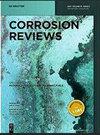Imidazoline behavior as corrosion inhibitor in the electrochemical characterization of SCC behavior of an API X70 steel exposed to brine solution
IF 3.2
4区 材料科学
Q3 ELECTROCHEMISTRY
引用次数: 1
Abstract
Abstract The effect of concentration of an organic imidazoline as inhibitor on internal stress corrosion cracking (SCC) behavior of an API X70 pipeline steel exposed to a brine solution was studied. The SCC process using simultaneously the slow strain rate stress test (SSRT) and electrochemical measurements was performed. Fracture surface analysis and secondary cracking were observed through a scanning electron microscopy (SEM). According to SEM fractography and SSRT results, the steel showed high SCC susceptibility with a brittle fracture and several secondary cracks without addition of inhibitor, whereas the addition of inhibitor to brine solution was effective to increase the SCC resistance of steel at concentrations of inhibitor of 50 and 100 ppm. A further addition of concentration of inhibitor had a negative effect on the mechanical properties of the steel. Electrochemical measurements results are in accordance with the SCC susceptibility, indicating that corrosion inhibitor film suppressed the anodic and cathodic reactions increasing the resistance to SCC until concentration of 100 ppm. Further addition of inhibitor aggravated the localized corrosion due to local desorption of inhibitor molecules. The Hilbert–Huang transform (HHT) analysis revealed the contribution of different corrosion process contained in the electrochemical current noise (ECN) signals at several inhibitor concentrations.咪唑啉作为缓蚀剂在API X70钢盐溶液中SCC行为的电化学表征
摘要研究了有机咪唑啉缓蚀剂浓度对API X70管线钢在盐水溶液中的内应力腐蚀开裂(SCC)行为的影响。同时使用慢应变速率应力测试(SSRT)和电化学测量进行SCC过程。通过扫描电子显微镜(SEM)观察了断裂表面分析和二次开裂。根据SEM断口形貌和SSRT结果,在不添加抑制剂的情况下,钢表现出高的SCC敏感性,具有脆性断裂和几个二次裂纹,而在50和100ppm的抑制剂浓度下,向盐水溶液中添加抑制剂可以有效地提高钢的抗SCC性。进一步添加抑制剂浓度对钢的力学性能有负面影响。电化学测量结果与SCC敏感性一致,表明缓蚀剂膜抑制了阳极和阴极反应,增加了对SCC的抵抗力,直到浓度达到100ppm。由于抑制剂分子的局部解吸,进一步添加抑制剂加剧了局部腐蚀。Hilbert–Huang变换(HHT)分析揭示了在几种抑制剂浓度下,电化学电流噪声(ECN)信号中包含的不同腐蚀过程的贡献。
本文章由计算机程序翻译,如有差异,请以英文原文为准。
求助全文
约1分钟内获得全文
求助全文
来源期刊

Corrosion Reviews
工程技术-材料科学:膜
CiteScore
5.20
自引率
3.10%
发文量
44
审稿时长
4.5 months
期刊介绍:
Corrosion Reviews is an international bimonthly journal devoted to critical reviews and, to a lesser extent, outstanding original articles that are key to advancing the understanding and application of corrosion science and engineering in the service of society. Papers may be of a theoretical, experimental or practical nature, provided that they make a significant contribution to knowledge in the field.
 求助内容:
求助内容: 应助结果提醒方式:
应助结果提醒方式:


